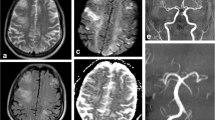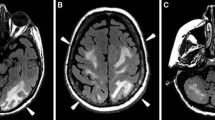Abstract
With increasing numbers of solid organ and hematopoietic stem cell transplantations being performed, there have been significant increases in the use of immunosuppressive agents such as cyclosporine and tacrolimus. Posterior reversible encephalopathy syndrome (PRES) is a serious complication of immunosuppressive therapy use following solid organ or stem cell transplants. Clinical findings including headache, mental status changes, focal neurological deficits, and/or visual disturbances. Associated with these are characteristic imaging features of subcortical white matter lesions on computed tomography (CT) or magnetic resonance imaging (MRI). The changes in the subcortical white matter are secondary to potentially reversible vasogenic edema, although conversion to irreversible cytotoxic edema has been described. These imaging findings predominate in the territory of the posterior cerebral artery. Many studies have shown that the neurotoxicity associated with tacrolimus may occur at therapeutic levels. In most cases of PRES, the symptom complex is reversible by reducing the dosage or withholding the drug for a few days. While PRES is an uncommon complication, it is associated with significant morbidity and mortality if it is not expeditiously recognized. MRI represents the most sensitive imaging technique for recognizing PRES. This report highlights the value of MRI in prompt recognition of this entity, which offers the best chance of avoiding long-term sequelae.


Similar content being viewed by others
References
Wong R, Beguelin GZ, de Lima M, Giralt SA, Hosing C, Ippoliti C, Forman AD, Kumar AJ, Champlin R, Couriel D (2003) Tacrolimus-associated posterior reversible encephalopathy syndrome after allogenic hematopoietic stem cell transplantation. Br J Haematol 122:128–134. doi:10.1046/j.1365-2141.2003.04447.x
Eidelman BH, Abu-Elmagd K, Wilson J, Fung JJ et al (1991) Neurologic complications of FK-506. Transplant Proc 23:3175–3178
Hauser RA, Lacey DM, Knight MR (1988) Hypertensive encephalopathy: magnetic resonance imaging demonstration of reversible cortical and white matter lesions. Arch Neurol 45:1078–1083
Nakamura M, Fuchinoue S, Sato S et al (1998) Clinical and radiological features of two cases of tacrolimus-related posterior leukoencephalopathy in living related liver transplantation. Transplant Proc 30:1477–1478. doi:10.1016/S0041-1345(98)00323-6
Jarosz JM, Howlett DC, Cox TC, Bingham JB (1997) Cyclosporine-related reversible posterior leukoencephalopathy. MRI Neuroradiology 39:711–715. doi:10.1007/s002340050492
Ito Y, Arahata Y, Goto Y, Hirayama M et al (1998) Cisplatin neurotoxicity presenting as reversible posterior encephalopathy syndrome. AJNR Am J Neuroradiol 19:415–417
Delanty N, Vaughan C, Frucht S, Stubgen P (1997) Erythropoietin-associated hypertensive leukoencephalopathy syndrome. Neurology 49:686–689
Trommer BL, Homer D, Mikhel MA (1988) Cerebral vasospasm and eclampsia. Stroke 19:326–329
Covarrubias DJ, Luetmer PH, Campeau NG (2002) Posterior reversible encephalopathy syndrome: prognostic utility of quantitative diffusion weighted MR images. AJNR Am J Neuroradiol 23:1038–1048
Casey SO, Sampaio RC, Michel E, Truwit CL (2000) Posterior reversible encephalopathy syndrome: utility of FLAIR imaging in the detection of cortical and subcortical lesions. AJNR Am J Neuroradiol 21:1199–1206
Appignani B, Bhadella R, Blacklow S, Wang A et al (1996) Neuroimaging findings in patients on immunosuppressive therapy: experience with tacrolimus therapy. AJR Am J Roentgenol 166:683–688
Mukherjee P, McKinstry RC (2001) Reversible posterior encephalopathy syndrome: evaluation with diffusion tensor imaging. Radiology 219:56–765
Provenzale JM, Petrella JR, Celso LH, Wong JC et al (2001) Quantitative assessment of diffusion abnormalities in posterior reversible encephalopathy syndrome. AJNR Am J Neuroradiol 22:1455–1466
Edvinson L, Owman C, Sjoberg NO (1976) Autonomic nerves, mast cells and amine receptors in human brain vessels, a histochemical and pharmacological study. Brain Res 115:337–393. doi:10.1016/0006-8993(76)90356-5
Schwartz RB, Feske SK, Polak JF et al (2000) Preeclampsia-eclampsia: clinica and neuroradiologic correlates and insights into the pathogenesis of hypertensive encephalopathy. Radiology 217:317–376
Bartynski WS, Boardman JF (2008) Catheter angiography, MR angiography and MR perfusion in posterior reversible encephalopathy syndrome. AJNR Am J Neuroradiol 29(3):44–55. doi:10.3174/ajnr.A0839
Author information
Authors and Affiliations
Corresponding author
Rights and permissions
About this article
Cite this article
Hodnett, P., Coyle, J., O’Regan, K. et al. PRES (posterior reversible encephalopathy syndrome), a rare complication of tacrolimus therapy. Emerg Radiol 16, 493–496 (2009). https://doi.org/10.1007/s10140-008-0782-6
Received:
Accepted:
Published:
Issue Date:
DOI: https://doi.org/10.1007/s10140-008-0782-6




